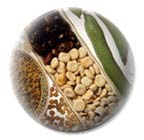- Home
- Introductions

|
Vegetable Seed Production: Wet Seed PrinciplesVegetable seed crops are divided into two categories based on the type of fruit harvested. Dry-seeded fruits include the brassicas, legumes, and onion and wet-seeded fruits include the cucurbits, melons, and tomatoes. The methods of harvest and extraction of seeds vary dependon whether seeds are dry or wet at harvest. Seed harvest from wet-seeded fruits is often determined by fruit color. Seed quality in pepper as determined by percentage germination and rate of germination is higher in seeds harvested from red fruits compared to those harvested from green fruits. In tomatoes, maximum seed germination is attained when the fruits are at a mature green stage compared to those which are at the red or fully-ripe stages.
After the fruits are determined to be at the correct stage for maximum seed quality, they are gathered and the seed extracted. In some cases, this is done in one mechanical operation where the fruit is picked from the row, conveyed to a crushing mechanism, and the pulp removed from the seed by washing with water in a rotating drum. pict of watermelon from courseware site In most cases, vegetable seed companies mechanically harvest crops such as tomatoes, peppers, and cucumber in the field, transport the fruit to a central extraction plant, and remove the seeds from the fruit. In tomato, cucumber, and cantaloupe, a mucilaginous layer around the seed must be removed prior to cleaning. This can be done by two methods. The first, and most common, is the retention of seeds in the crushed fruit pulp for a few hours to more than a day so that fermentation occurs. This process is closely monitored because the fermentation creates heat and mechanical injury to the seeds if continued too long. The second approach is to add sodium carbonate or hydrochloric acid to the crushed fruit extract to degrade the mucilaginous layer. After the fruit is crushed and any mucilaginous layer removed, the seed is separated from the pulp and passed along a water sluice containing gates along its entire length. Mature high quality seeds sink behind the gates and are separated from the pulp by the running water. After the pulp is removed, the sluice gates are opened and the mature seeds captured on a screen. At this stage, the wet seed must be promptly dried to avoid heating and loss of seed quality with increasing imbibition. To accomplish this, the wet seeds are collected and placed into a spin dryer to remove excess water and the moist seeds are evenly spread on screens and exposed to large volumes of heated air.
After drying is completed, the seeds are handled and conditioned in the same way as employed for dry-seeded vegetable crops. Examples of direct and indirect harvest methods for wet-seeded vegetable seed crops are provided below in Table I. Table I. Conventional harvest methods for wet-seeded vegetable seed crops based on their mature reproductive structures (courtesy of J. J. Steiner).
|
||||||||